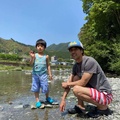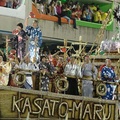A few years ago, I came up with an idea to make a documentary about overseas Okinawan communities. I wanted to show that Okinawans left their island home for places all over the globe, but no matter where they went, the migrants took their culture and traditions with them. I created a plan to visit places where Okinawans settled in Peru, Hawaii, Los Angeles, CA and Jacksonville, NC. That’s right, a tiny little place called Jacksonville.
For my documentary, I went as far as buying a video camera and a round trip ticket to Jacksonville. The opportunity came from my aunt who is from Okinawa but now lives in Los Angeles. She was going to visit a friend and attend the Jacksonville Okinawan Kenjinkai Shinenkai – their New Year’s celebration. I would tag along and videotape the experience.
Jacksonville is located just outside Camp LeJeune Marine Base. The Okinawa community is made up entirely of women; the wives of U.S. servicemen who followed their husbands to a new land. Because of the location and intermarriage, these women lead “Americanized” lives. But what I discovered on my trip was that they still have a strong sense of Okinawan identity and formed tight bonds with each other for support.
Through my aunt’s friend I was introduced to a number of people in the community who made me feel very welcome and openly shared their stories of adapting to life in America. The husband of my aunt’s friend was a retired Marine who made Clint Eastwood look soft. But even Marines fall in love. The couple shared with me how they met and how the wife’s family hid her in the countryside to keep them apart and how she ran away from home to get married and leave Okinawa. Now at their home in North Carolina, everything looks very American, from the family portraits on the wall to the ceramic figurines that decorate the dining room, but everyone takes off their shoes inside the house, even the old Marine.
I got to meet the members of the Eisa dance and taiko group and went to their practice in a shack in the middle of the woods. No neighbors to disturb with the loud drumming, except for maybe the squirrels. The group was made up of some Okinawan wives and about six children and grandchildren from other families. There were other people at the practice too—some husbands and their buddies. Mostly they were there to drink beer and hang out. The best part of the night was with the camera rolling, watching one of the men tease the Okinawan ladies with the bad words he picked up in the Okinawan language.
After a visit to the Kenjinkai clubhouse (not a shack in the woods, but a large auditorium sized building) where the ladies were preparing for the Shinenkai for the following day, the club president invited me to dinner. She took drove me over to a bar on the side of the highway. From the outside the building look unspectacular; just a step up from the shack actually. Inside it was dark. People came here to smoke and drink. I guess you only needed enough light to see how much beer was left in your bottle. I went to the back where the bar owner was in the kitchen surrounded by steaming pots of water and a wok that gurgled with boiling oil. She was busy making a feast of Okinawan soba and tempura and for dessert, andagi or Okinawan donuts. She was unaffected by a stranger invading her space, but couldn’t grasp why he would want to videotape her cooking. She told me how two decades earlier when she arrived in North Carolina, there was no place to get Japanese food. They made yakisoba with spaghetti noodles. They also found some wild greens that they would pick in the fields and cook. Today Jacksonville has a Japanese grocery store in a mini-mall. It’s located right next to an authentic Japanese/Okinawan restaurant called Yakitori House. There’s even goya (bittermelon, an Okinawan staple) on the menu. I haven’t found a place in LA that serves goya since Kappa Café in Gardena closed down.
On Sunday, I got up early and went to the Baptist church. The small room for Sunday school class was filled with Okinawan women. A Japanese man led the class. He was a missionary who traveled to churches in the area to serve the Japanese-speaking community. Most of the ladies in their Sunday dresses were middle-aged, but there were a couple of the younger wives. I wish I had an opportunity to chat with them about their experiences, but didn’t know how to approach them.
An amazing person I met on this trip was a woman with white hair who was probably the most senior of the Jacksonville ladies. She didn’t want me to videotape her, but didn’t mind answering any questions I had. In Okinawa there is a place called the Himeyuri Memorial dedicated to a group of female high school students who committed suicide rather than surrender to the U.S. troops during the Battle of Okinawa in World War II. The Japanese Army led them to believe that they would be raped and killed by the Americans and that suicide was their only choice. This graceful woman was a classmate of the Himeyuri students, but her father, a teacher, kept her home that day. Her fate led her to America as a war bride where she raised her daughter and enjoyed a long and healthy life.
On the day of the Shinenkai, the clubhouse was bustling with activity. The entire auditorium was filled with people. All the wives were Okinawan. They ranged from the 20s to the 70s with most of the women in their 40s and 50s. All the husbands were Marines. All the children were hapa. There were even grandchildren with blond hair and blue eyes—no visible hint that they too were uchinanchu (Okinawan word for the Okinawan people).
The event program contained a long list of performances. Traditional dance, a kid’s dance, a shamisen performance, karaoke of Okinawan songs and of course the Eisa dance group and taiko. The highlight of the evening had to be a folksy couples dance. Dressed in Okinawan kimono, husband and wife teams were repeating the same steps that their uchinanchu cousins were dancing half-a-world away.
I briefly spoke with one man who had joined the uchinanchu clan by marrying one of the hapa children. He told me that he had never seen anything like this before. For some reason, his comment gave me reason to pause. He had married a woman that he only half knew. I did have several chances to speak with the adult children of the Okinawan wives. They were all very proud of their mothers and were aware of the hardships that needed to be overcome. The children were brought up American, but on that day, everybody was Okinawan.
So that was my trip to Jacksonville, North Carolina. I never did make that documentary. I didn’t capture all the video that I needed to tell the stories that I had heard. I probably won’t make it back to North Carolina, but I am sure I will meet some of the Jacksonville Okinawan Kenjinkai members again. They always send a group to the Worldwide Uchinanchu Festival held every five years in Okinawa. I plan on going to the next one and look forward to reuniting with my uchinanchu aunties once more.
© 2008 Bobby Okinaka





